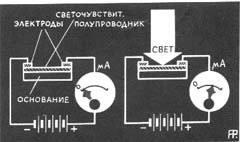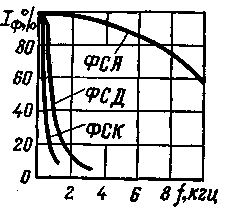
|
|
ENCYCLOPEDIA OF RADIO ELECTRONICS AND ELECTRICAL ENGINEERING Photoresistors. Reference data. Encyclopedia of radio electronics and electrical engineering
Encyclopedia of radio electronics and electrical engineering / Reference materials Semiconductor photocells - photoresistors have the ability to change their active resistance under the action of light falling on them. Photoresistors have a high sensitivity to radiation in the widest range - from the infrared to the X-ray region of the spectrum, and their resistance can vary by several orders of magnitude. Photoresistors are characterized by high stability over time, they are small in size and are available in various resistance values. The most widespread are photoresistors made of lead sulfide, cadmium sulfide, and cadmium selenium. The name of the type of photoresistors is composed of letters and numbers, and in the old designations the letters A, K, D denoted the type of photosensitive material used, in the new designation these letters were replaced by numbers. The letter behind the hyphen, with the old designation, characterized the design (L-sealed, P-film). In the new marking, these letters are also replaced by numbers. In table. 1 shows the names of the most common designations of photoresistors. Table 1. TYPICAL DESIGNATIONS OF PHOTORESISTORS
The photosensitive element in some types of photoresistors is made in the form of a round or rectangular tablet pressed from powdered cadmium sulfide or selenide, in others it is a thin layer of semiconductor deposited on a glass base. In both cases, two metal leads are connected to the semiconductor material. Schematically, the device of the photoresistor and its inclusion is shown in Fig.
Depending on the purpose, photoresistors have a completely different design. Sometimes it is just a semiconductor plate on a glass base with current-carrying leads, in other cases the photoresistor has a plastic case with rigid pins. Among such photoresistors, special mention should be made of the FSK-6, adapted for operation from reflected light, for which its body has a hole in the center for light to pass to the reflecting surface. Photoresistors are produced in a metal case with a base resembling a lamp, or in a case, like sealed capacitors or transistors. Small-sized film photoresistors are produced in plastic and metal cases with a moisture-proof coating of the photosensitive element with transparent epoxy resins. The appearance and dimensions of the most common types of photoresistors are shown in Fig.2.
Photoresistors are characterized by the following parameters (see Table 2): - dark resistance Rt - active resistance in the absence of illumination. Table 2. PARAMETERS OF PHOTORESISTORS
The table shows the average values determined (except for It) at an illumination of 200 lux. With some types of photoresistors, the dark resistance can vary considerably; - the multiplicity of changes in resistance Rt / Rsv, a parameter showing the ratio of dark resistance to resistance in the illuminated state. This is one of the most important parameters characterizing the sensitivity of the photoresistor. With an increase in illumination, the multiplicity increases according to a linear law, with a decrease, it decreases. Lead-sulfur photoresistors have the least sensitivity, in which the multiplicity at illumination of 200 lux is not lower than 1,2. For other types of photoresistors, the sensitivity is much higher; - operating voltage, which refers to the voltage that guarantees continuous operation of the photoresistor. When operating in a pulsed mode for cadmium sulfide and cadmium selenium photoresistors, the allowable voltage can be 2-3 times higher than the operating voltage. For lead-sulfur photoresistors, the operating voltage can be taken equal to 0,1 Rt, where Rt is in kiloohms; - allowable power dissipation, allowing long-term operation of the photoresistor at +20 ° C in the environment without the risk of irreversible changes in the photosensitive layer; - spectral characteristics showing in which part of the spectrum the photoresistor has the highest sensitivity. Approximate spectral characteristics are shown in Fig.3.
As can be seen from these characteristics, photoresistors with a cadmium sulfide photosensitive element have a maximum sensitivity in the visible part of the spectrum, photoresistors made on the basis of cadmium selenium are most sensitive in the red and infrared parts of the spectrum, and lead sulfide photoresistors have a maximum sensitivity in the infrared region spectrum. An important parameter of photoresistors is the specific sensitivity, which is calculated by the formula:
where: DI - photocurrent, mA; L - illumination, lx; S - the size of the photosensitive area, cm2; U is the voltage applied to the photoresistor, B. If the sensitivity value is multiplied by the operating voltage, then the integral sensitivity will be obtained. In addition, the properties of photoresistors are characterized by current-voltage characteristics, which show the dependence of the current through the photoresistor on the voltage applied to it (see Fig. 4, a). This characteristic is linear over a fairly wide range. For some types of photoresistors, at voltages lower than the operating voltage, nonlinearity is observed (Fig. 4b).
Photoresistors have inertia, which can be judged by the frequency response shown in Fig. 5. This characteristic expresses the relationship between the magnitude of the photocurrent and the modulation frequency of the light flux incident on the photoresistor. As can be seen from the characteristic, the magnitude of the signal taken from the photoresistor decreases with increasing frequency of the modulation of the light flux.
The sensitivity of photoresistors changes (decreases) in the first 50 hours of operation, remaining practically constant throughout the entire service life, measured in several thousand hours. The operating temperature range for cadmium sulfide photoresistors is from -60 to +85°C, for cadmium selenium - from -60 to +40°C and for lead sulfide - from -60 to +70°C. The main field of application of photoresistors is automation, where in some cases they successfully replace vacuum and gas-filled photocells. Possessing an increased allowable power dissipation compared to some types of photocells, photoresistors make it possible to create simple and reliable photorelays without current amplifiers. Such photo relays are indispensable in devices for remote control, monitoring and regulation, in automatic sorting machines, when sorting and counting finished products, for quality control and readiness of a variety of parts. Photoresistors are widely used in the printing industry to detect paper tape breaks, control the number of sheets fed into the printing machine. In measuring technology, photoresistors are used to measure high temperatures, to control the temperature in various technological processes. Control of the level of liquids and loose bodies, protection of personnel from entering hazardous areas, control of dust and smoke levels of various objects, automatic street lighting switches and turnstiles in the subway - this is not a complete list of applications for photoresistors. Photoresistors have found application in medicine, agriculture and other fields. At present, it is difficult to find such a branch of the national economy, where they would not be used to increase labor productivity, improve product quality and facilitate human labor.
Publication: N. Bolshakov, rf.atnn.ru
Traffic noise delays the growth of chicks
06.05.2024 Wireless speaker Samsung Music Frame HW-LS60D
06.05.2024 A New Way to Control and Manipulate Optical Signals
05.05.2024
▪ Cocoa with flavonoids makes people smarter ▪ Power supplies Dark Power 12 ▪ U.S. renewable power plants surpass coal-fired power
▪ site section Voltage converters, rectifiers, inverters. Article selection ▪ article And the thread, twisted three times, will not break soon. Popular expression ▪ article Are the further adventures of Robinson Crusoe described? Detailed answer ▪ article How to do without freon. Children's Science Lab ▪ article Lollipops. Simple recipes and tips
Comments on the article: Sasha Great site. Lots of information and a wide variety of pictures. RosGirl The bypass connection has a smoother transfer characteristic, a lower level of non-linear distortion, but the depth of adjustment of the transfer coefficient is limited to 60 dB Victor Very interesting and useful information [up] Edward Very good site, lots of reference material. Many thanks to the creators of the site.
Home page | Library | Articles | Website map | Site Reviews www.diagram.com.ua |






 Arabic
Arabic Bengali
Bengali Chinese
Chinese English
English French
French German
German Hebrew
Hebrew Hindi
Hindi Italian
Italian Japanese
Japanese Korean
Korean Malay
Malay Polish
Polish Portuguese
Portuguese Spanish
Spanish Turkish
Turkish Ukrainian
Ukrainian Vietnamese
Vietnamese






 Leave your comment on this article:
Leave your comment on this article: